This post contains affiliate links.
This article identifies and describes Vermont hummingbirds, where in Vermont they are seen, and if they are year-round, seasonal, or rare vagrant residents.
Which Species Of Vermont Hummingbirds Are Found In The State?
There are three species of hummingbirds documented as seen in Vermont.
Documented Vermont hummingbirds, listed in order of frequency seen are Ruby-throated, Rufous, and Mexican Violetear hummingbirds.
Listed In The Order Of Frequency Seen:
These are the Vermont statistics at the end of 2023, as reported by eBird.org.
Click the “Documented” link below for the current Vermont stats.
| Hummingbirds: | Number Seen: | Documented: |
| Ruby-throated | 45,705 | Documented |
| Rufous | 47 | Documented |
| Mexican Violetear | 4 | Documented |
| Total Seen: | 45,756 |
These 3 hummingbird species are found in Vermont and are further classified into three groups:
Year-round residents, Seasonal visitors, and Rare/Vagrant visitors.
| Hummingbird: | Year-Round, Seasonal, Rare/Vagrant |
| Ruby-throated | Seasonal |
| Rufous | Rare/Vagrant |
| Mexican Violetear | Rare/Vagrant |
For more information on Vermont hummingbirds: Read my article: Vermont Hummingbird Migration
Vermont Hummingbirds That Are Year-Round Residents
There are no hummingbirds classified as year-round residents in Vermont.
This hummingbird classification is defined as year-round residents residing in Vermont 365 days a year.
Vermont hummingbirds, the Ruby-throated, Rufous, and Mexican violetear hummingbirds, migrate south to their wintering grounds during fall migration. However, a small number of hummingbirds are reported to be seen during the winter months in Vermont.
Contrary to popular belief, hummingbirds can withstand far lower temperatures than most people would expect.
Some banded hummingbirds have been observed at temperatures as low as -9 degrees Fahrenheit with a wind chill of -36 degrees Fahrenheit, according to eBird.org.
See my article: 3 Reasons Why Hummingbirds Are Banded
Vermont Hummingbirds That Are Seasonal
There is only one Vermont hummingbird classified as a seasonal hummingbird, which is the Ruby-throated hummingbird.
Hummingbirds that fit within this category are those that migrate through Vermont on a spring or fall emigration basis.
Hummingbirds move south to spend the winter in Mexico and Central America in the fall after migrating north in the spring to reproduce.
Due to their preference, an ailment, or advanced age, certain seasonal hummingbirds may spend the whole winter in the state.
To see a current sighting map of Vermont seasonal hummingbirds,
click the links below:
RUBY-THROATED HUMMINGBIRD – (Archilochus colubris)
Conservation Status: Least concerned
Kingdom: Animalia
Phylum: Chordata
Class: Aves
Order: Apodiformes
Family: Trochilidae
Genus: Archilochus
Species: A. colubris
Scientist Carl Linnaeus of Sweden is credited with giving the Ruby-throated hummingbird its scientific name. He initially classified the species as “Trochilus colubris.”
Its name was revised more than a century later when German botanist Ludwig Reichenbach classed it as “Archilochus colubris,” which is now its scientific name and means “sky spirit/sun-god bird” or “top thief.”
Male Ruby-throated hummingbirds:
The beautiful iridescent blood-red gorget of male Ruby-throated hummingbirds ends at the neck.
His distinctive features are black wings, a light gray underbelly, and a dull metallic green topside.
The Ruby-throated hummingbird is a tiny species of hummingbird, measuring 2.8 to 3.3 inches in length and weighing less than 4.5 grams, or two U.S. dimes.
They live for three to five years on average.
The metal plate that shields the wearer’s throat during combat to prevent injuries is the inspiration behind the name of the gorget on a male hummingbird.
This name is acceptable and fitting to characterize the physical characteristics of male hummingbirds, since they fight fiercely for their own territory.
Read my article: Hummingbird Gorgets Explained

Photo by: MaryLou Ziebarth
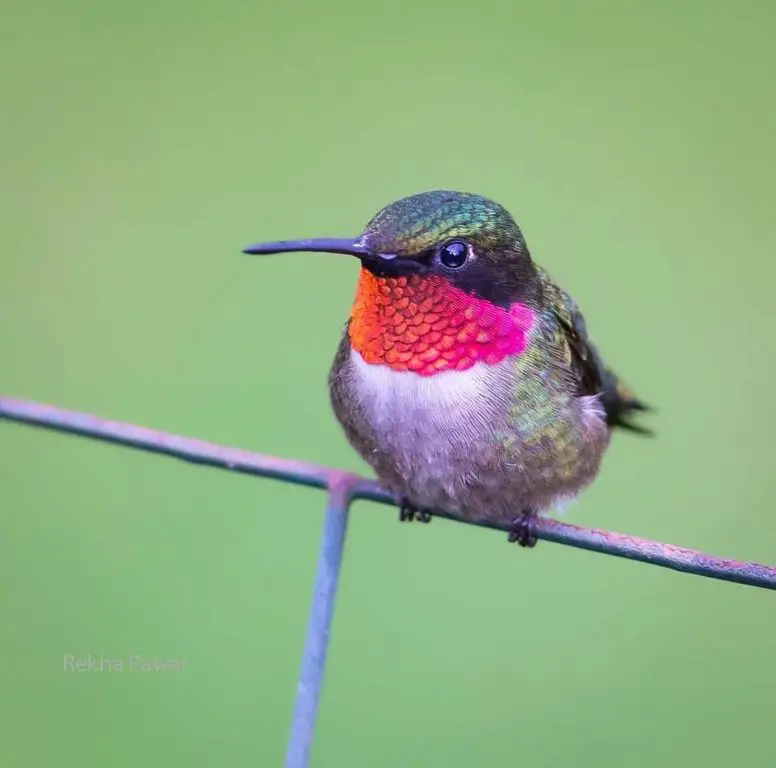
Photo by: Rekha Pawar
Female Ruby-throated hummingbirds:
Ruby-throated hummingbird females are usually larger than males, with a white throat stippled with light spots.
Ruby-throated hummingbird’s life expectancy is roughly three to five years.
The oldest female Ruby-throated hummingbird on record, at nine years old, is nearly twice as old as the male life expectancy.
See my article: Hummingbird Parents: (Mating to Nesting)

Photo by: Dgen.photos
Note: The pollen on her head and beak. This female Ruby-throated hummingbird has been busy pollinating and drinking nectar from flowers to sustain her high metabolism.
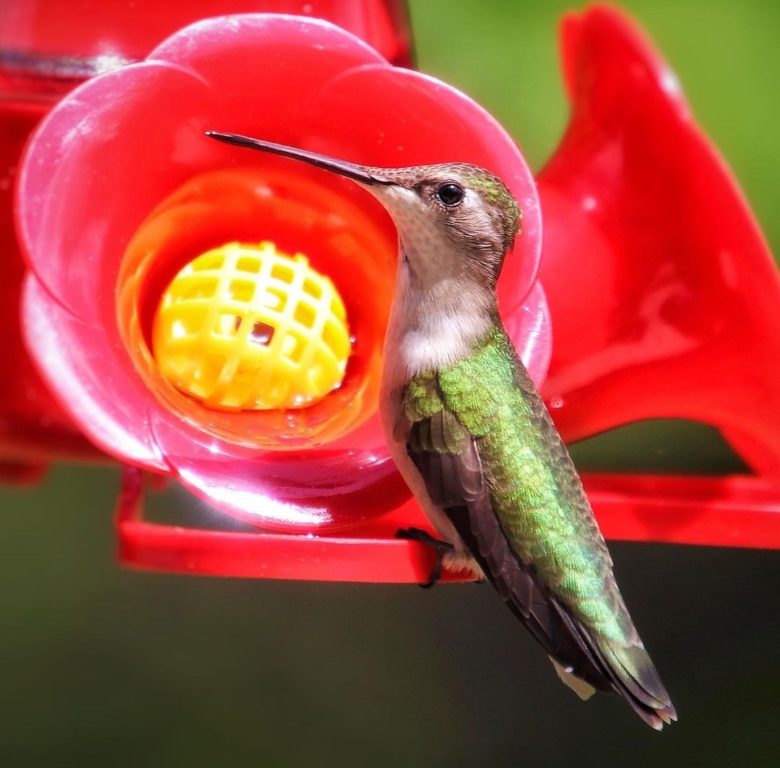
Photo by: Paula Leftwich
Juvenile Ruby-throated hummingbirds:
Ruby-throated hummingbird juveniles, both male and female, have a white throat with faint stippling, just like their mother.
As the males become older, they start to show some color around their necks, and finally their stronger red throat feathers take center stage and proudly show off a vibrant gorget.
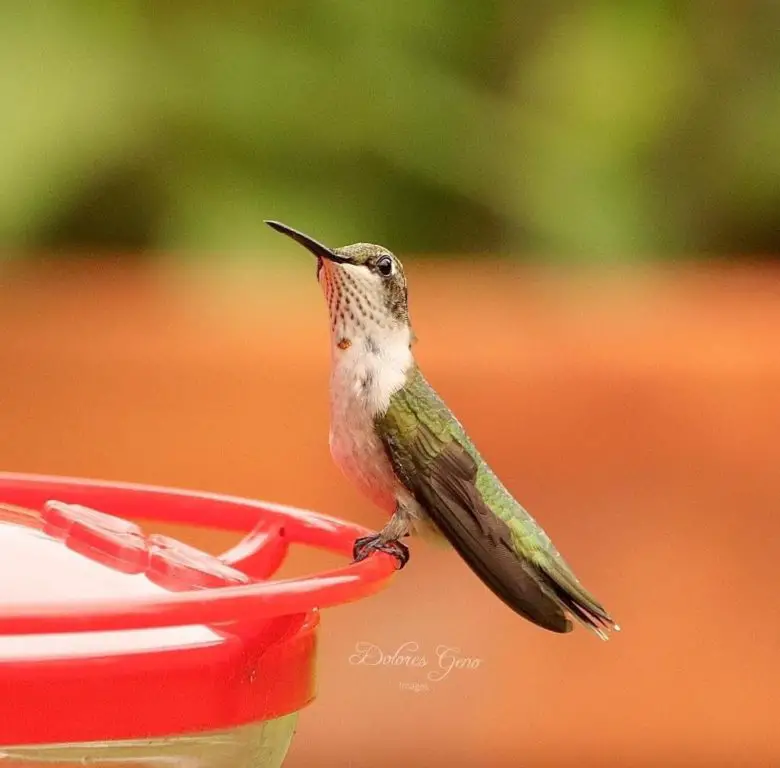
Photo by: Dgen.photos
Note: The throat feathers are slowly coming in, displaying a few dots of color near the neckline and showing the first stages of adolescence.

Photo by: MaryLou Ziebarth
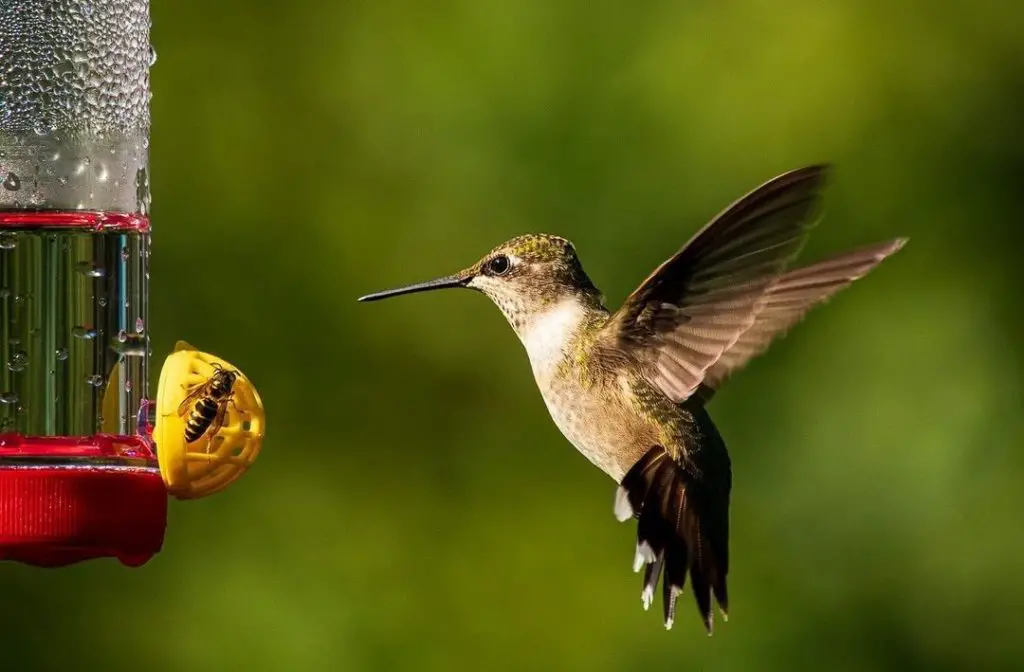
Photo by: MaryLou Ziebarth
Note: This juvenile Ruby-throated hummingbird is struggling with a bee or wasp situation at the feeder.
See my article: Bees On My Hummingbird Feeder: (9 Tips To Get Rid of Them)
Baby Ruby-throated hummingbirds:
Baby Ruby-throated hummingbirds are easily identified by their undertail coverts, which are white fluffy feathers near their bottom that will disappear as they age.
See my article: Baby Hummingbirds: (Egg to Fledgling)
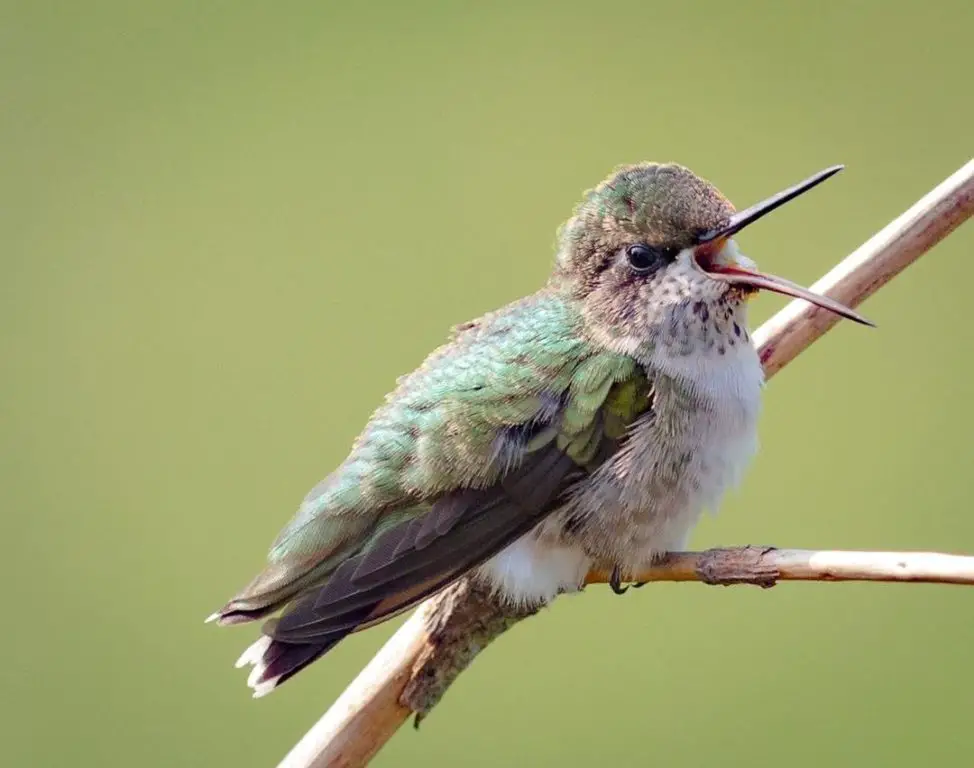
Photo by: Rekha Pawar
Note: The down feathers near the baby’s bottom are newly white and fluffy.
Observe the great fat reserves they have amassed from the feedings of their devoted mother’s, which will help them get through puberty.
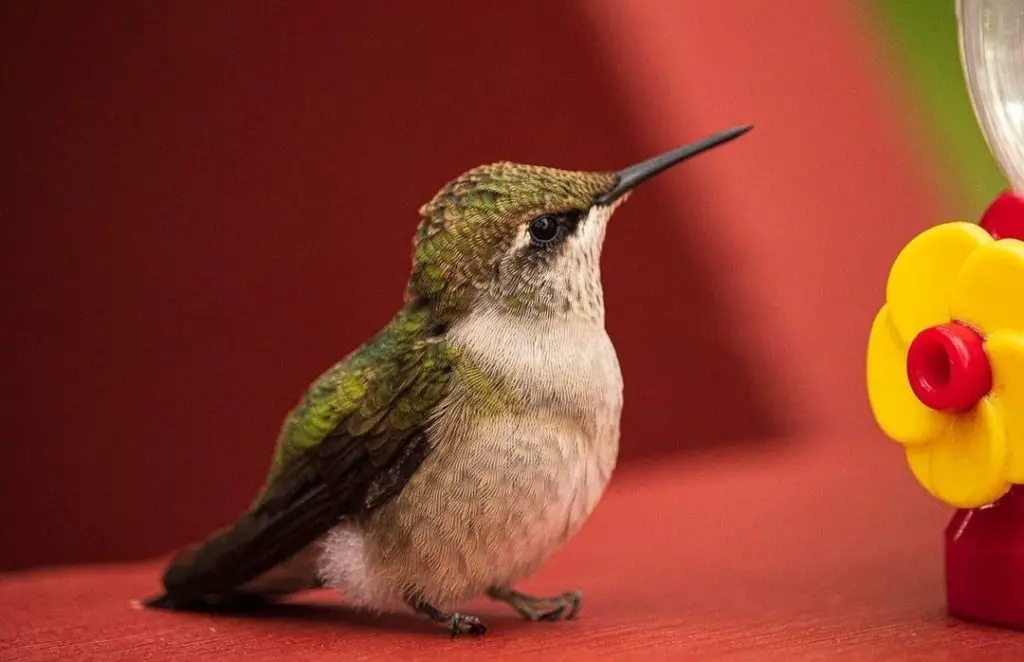
Photo by: MaryLou Ziebarth
To see the current sighting map of Vermont’s Ruby-throated hummingbirds, click the link.
Hear the sounds of the Ruby-throated hummingbird (Cornell Lab of Ornithology link).
99% of all Vermont hummingbird sightings will be Ruby-throated hummingbirds.
On average, out of 10,000 hummingbird sightings in Vermont, 9,989 will be of the Ruby-throated hummingbird.
The Ruby-throated hummingbird migrates via two different routes in the spring and fall.
The first migration route takes them directly, via the Gulf of Mexico, southwest to Mexico, where they travel nonstop until they reach Central America for the winter.
Over 500 miles is the flight distance over the Gulf of Mexico. Despite being the direct “short” route, these birds must overcome many difficulties.
The total direct flight from Burlington, Vermont, to Panama City, Panama, is 2,473 miles.
Not being able to rest, not having access to food or fuel, and needing to steer clear of the severe tropical Atlantic hurricanes while traveling to their destination are some of the challenges faced when flying over the Gulf of Mexico.
To exacerbate the situation, they migrate during the night or are conducting a “Red-eye flight,” depending on your point of view.
Even though both sexes double their body fat before beginning their arduous transoceanic migratory pattern across the Gulf of Mexico, researchers think that males’ energy consumption is more taxing due to their small stature.
The second land migration path is 4,741 miles long and follows the Gulf of Mexico’s shoreline. Even though there are fewer guarantees of food sources along the way, taking the “long” route gives them the chance to stop and replenish.
Scientists are unclear and continue to investigate why one group of birds would prefer to take one route over the other.
Read my article: Hummingbird Migration in Vermont
The majority of people are unaware of how tolerant hummingbirds are of chilly weather.
According to eBird.org, through branding practices in Wisconsin, the Ruby-throated and Rufous hummingbirds have been documented surviving in temperatures of -9F and wind chills of -36F.
Read my article: 3 Reasons Why Hummingbirds Are Banded
To provide the many hummingbirds that spend the winter in Vermont access to life-sustaining nectar, several Vermont hummingbird enthusiasts keep their hummingbird feeders up all winter long.
This altruistic deed also supplies nectar to other migrating species that are too injured or elderly to travel.
Read my article: 11 DIY Ways to Keep Hummingbird Nectar From Freezing
The Ruby-throated hummingbird is a common sight in parks, gardens, and backyards. It prefers open forests. Except for the breeding season, when they become ferociously territorial and hostile against hummingbirds of other species, they are solitary birds.
Despite their aggressive nature, these hummingbirds are eaten by predators like dragonflies, big crustaceans, praying mantises, and orb-weaver spiders.
Read my article: 10 Common Things That Kill Hummingbirds
Nine years and one month was the oldest known living female Ruby-throated hummingbird, found during a capture and release banding operation in West Virginia.
Read my article: 3 Reasons Why Hummingbirds Are Banded
Vermont Hummingbirds That Are Rare/Vagrant
There are two Vermont hummingbirds classified as rare or vagrant hummingbirds. They are the Rufous and Mexican Violetear hummingbirds.
Hummingbirds that live in a group outside of their typical geographic range are classified as belonging to this category.
These hummingbird species not only span a vast range of distinct geographic areas, but they are also known to occasionally interbreed, giving rise to hybrids.
Although they are not in their usual range, reports of seeing these hummingbirds in Vermont have been made.
To see a current sighting map of Vermont rare/vagrant hummingbirds,
click the links below:
RUFOUS HUMMINGBIRD – (Selasphorus rufus)
Conservation Status: Near threatened
Kingdom: Animalia
Phylum: Chordata
Class: Aves
Order: Apodiformes
Family: Trochilidae
Genus: Selasphorus
Species: S. rufous
The Latin word rubrum, which means “red,” is the source of the Rufous hummingbird’s name due to its reddish-brown color.
Male Rufous hummingbirds:
The orange-red gorget of a male rufous hummingbird is iridescent, and their tail and sides have a rusty hue. Their underside is beige to white, and their bill is black.
Along with chocolate brown dorsal feathers, males can also have green plumage with green spots on their rustic-looking backs or on the summit of their heads.
They weigh 3.2 grams and range in length from 2.8 to 3.5 inches.
The metal plate that shields the wearer’s throat during combat to prevent injuries is the inspiration behind the name of the gorget on a male hummingbird.
This name is acceptable and fitting to characterize the physical characteristics of male hummingbirds, since they fight fiercely for their own territory.
Read my article: Hummingbird Gorgets Explained
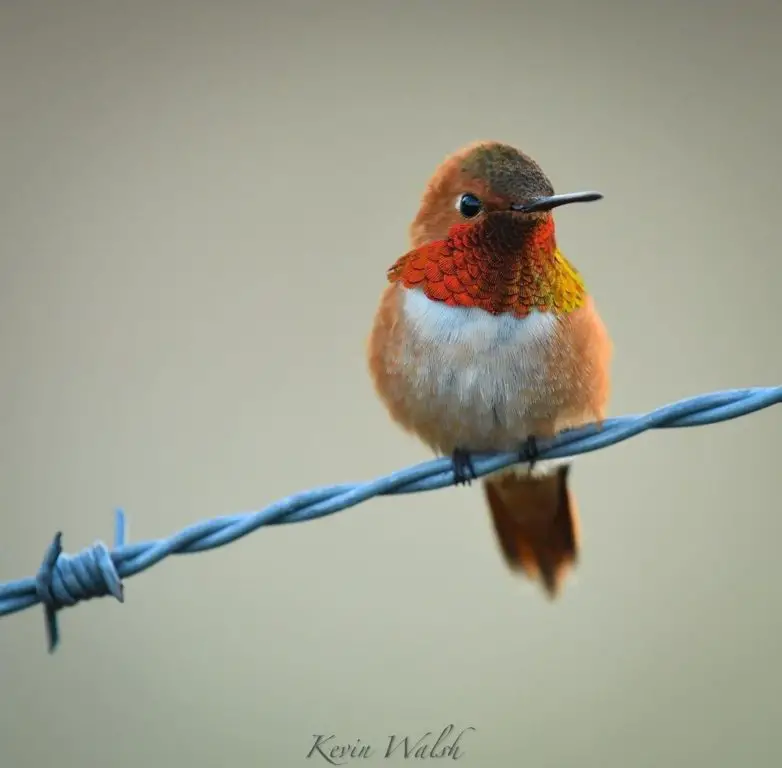
Photo by: Kevin Walsh
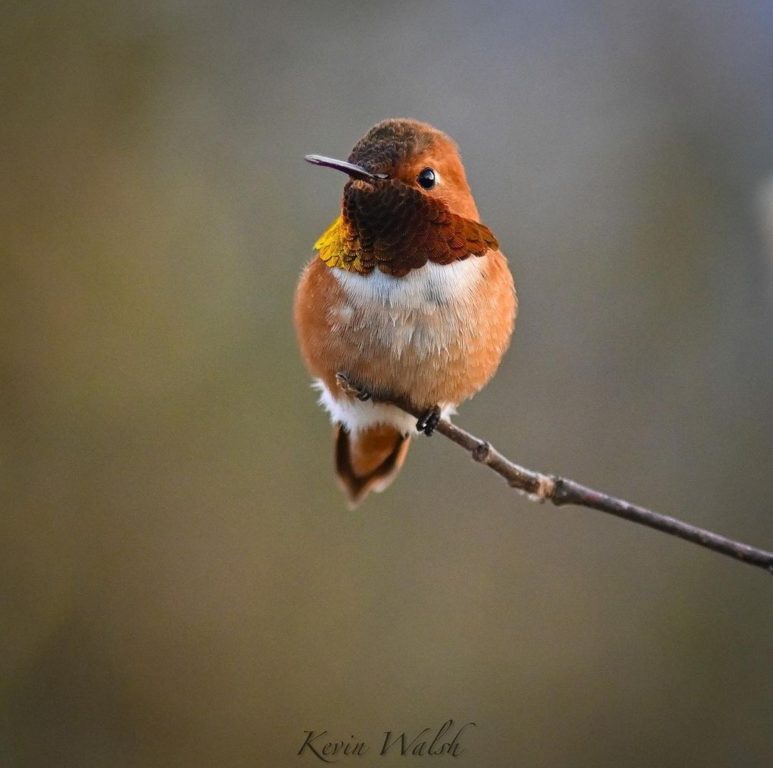
Photo by: Kevin Walsh
Female Rufous hummingbirds:
The female Rufous hummingbird is less colorful than the male because it lacks a gorget and iridescent feathers.
In the wild, confusion may arise, though, because certain females have stippling or color specs along their throat line that resemble juvenile characteristics.
They are slightly larger than the males in anticipation of producing offspring.
See my article: Hummingbird Parents: (Mating to Nesting)
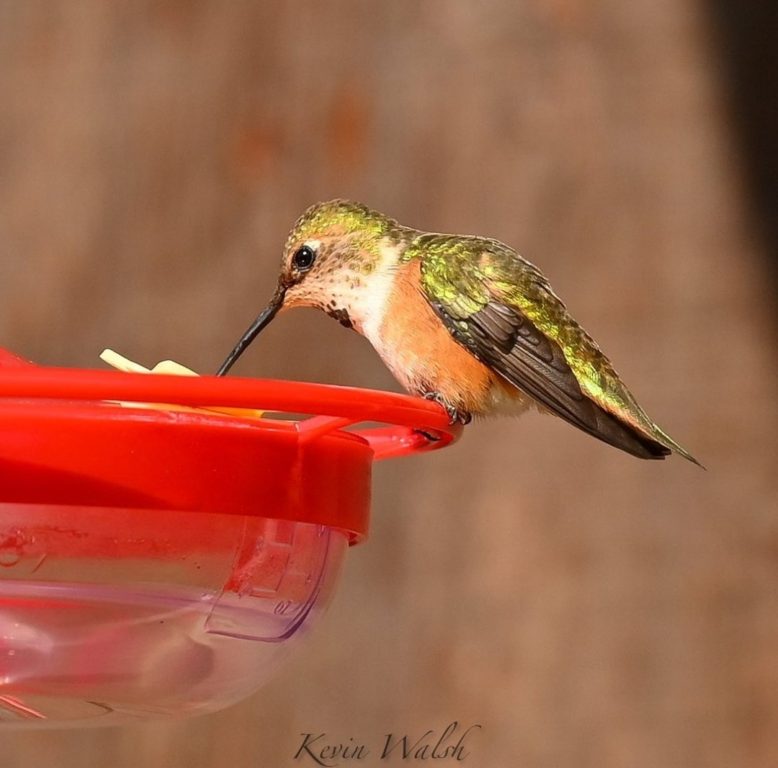
Photo by: Kevin Walsh
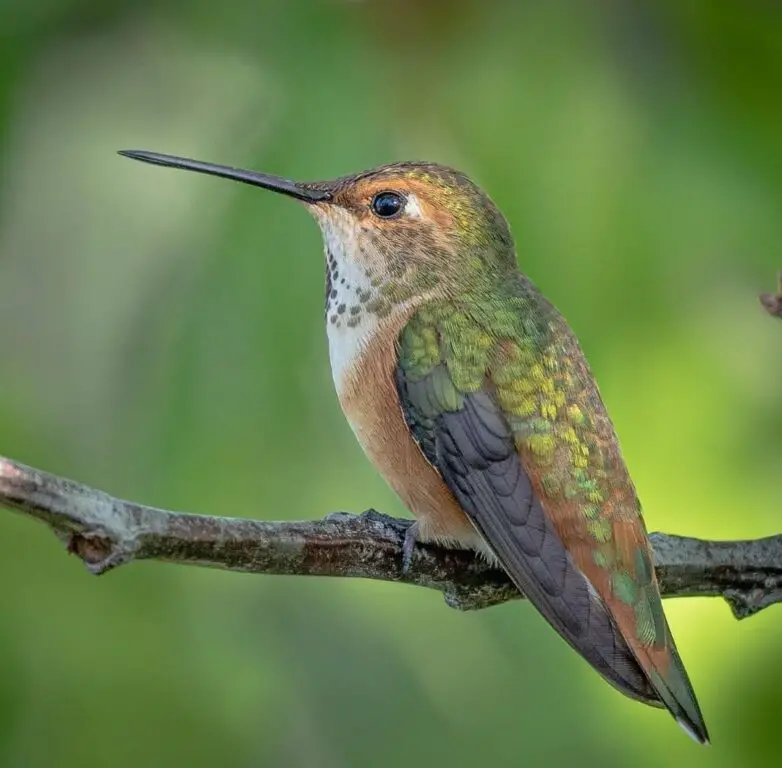
Photo by: Bob Free
They have one of the northernmost breeding ranges of any hummingbird in the world; migrating north from Mexico and nesting as far north as Alaska to breed during the summer months.
They are polygamous and will mate with several partners in a season.
Read my article: Hummingbird Parents: (Mating to Nesting)
Read my article: Baby Hummingbirds: (Egg to Fledgling)
Juvenile Rufous hummingbirds:
In the wild, juvenile Rufous hummingbirds and Allen’s hummingbirds are nearly identical in terms of color and behavior.
Therefore, range rather than appearance is used to establish identity.
The juvenile male Rufous’ rustic appearance is attributed to the iridescent orange dots on their neck.
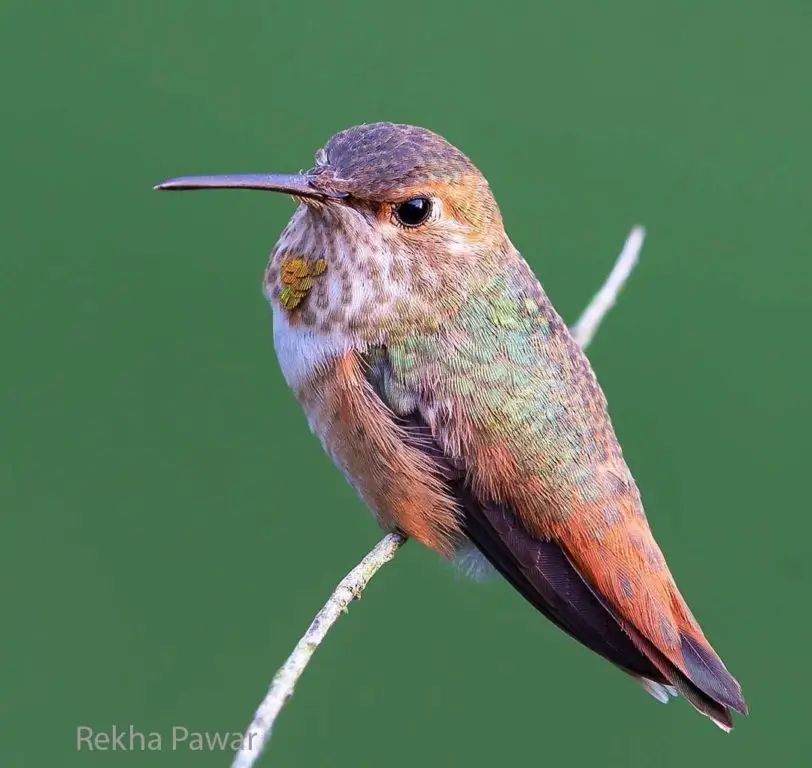
Photo by: Rekha Pawar
Note: The throat feathers are slowly coming in, displaying a few dots of color near his neckline and showing the first stages of adolescence.
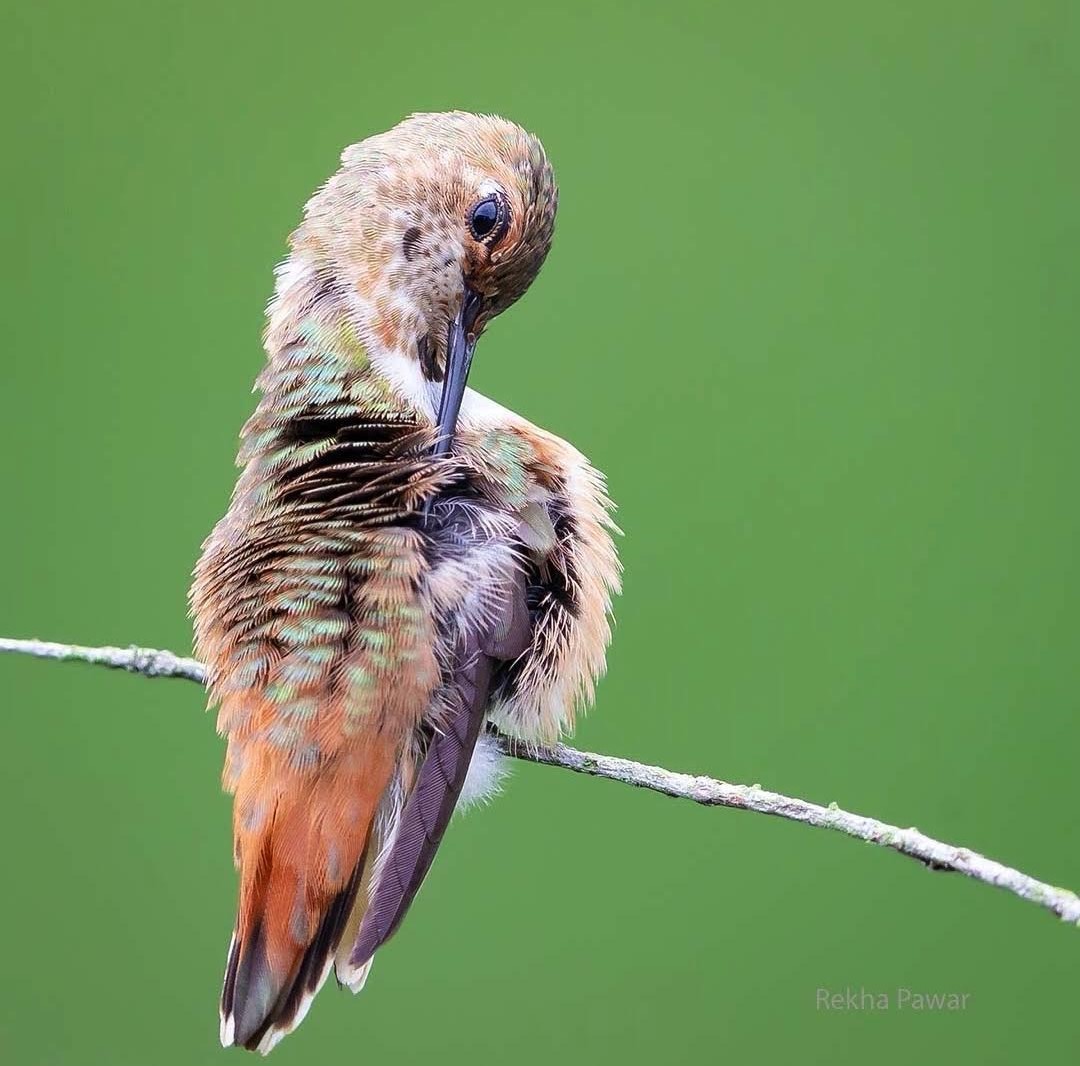
Photo by: Rekha Pawar
Note: Preening flight feathers is an important daily routine to maintain hygiene and to keep the feathers flexible, strong, in alignment, and parasite-free.
Baby Rufous hummingbirds:
Baby Rufous hummingbirds are easily identified by their undertail coverts, which are white fluffy feathers near their bottom that will disappear as they age.
See my article: Baby Hummingbirds: (Egg to Fledgling)
To see the current sighting map of Rufous hummingbirds in Vermont, click the link.
Hear the sounds of the Rufous hummingbird (Cornell Lab of Ornithology link).
10% of all Vermont hummingbird sightings will be Rufous hummingbirds.
On average, out of 10,000 hummingbird sightings in Vermont, only 10 will be a Rufous hummingbird.
Of all the birds in the world, Rufous hummingbirds migrate within the United States for the longest period of time. Every year, they traverse 3,900 miles in a clockwise manner around western America.
This migratory pattern during the seasons coordinates their arrival perfectly while catching nectar and blooming flowers throughout the year, fueling their bodies for their long journey.
To support a healthy migration, hummingbird enthusiasts are very beneficial when they cultivate blooming plants to draw hummingbirds and supply feeders with homemade hummingbird nectar.
These friendly environments offer and guarantee safe trips in addition to a dependable haven for relaxation and refueling while on the road.
A large number of Rufous hummingbirds will choose to move south to Mexico rather than stay in Vermont for the winter. Hummingbirds, however, can withstand far lower temperatures than most people think.
According to eBird.org, through branding practices in Wisconsin, the Rufous and Ruby-throated hummingbirds are documented surviving in temperatures of -9F and wind chills of -36F.
See my article: 3 Reasons Why Hummingbirds Are Banded
This selfless act also provides nectar to other injured or older hummingbirds that are unable to migrate.
See my article: 11 DIY Ways to Keep Hummingbird Nectar From Freezing
When it comes to other hummingbirds and animals, Rufous hummingbirds are fiercely possessive and hostile. They are known for being aggressive and bold, driving large birds and rodents away from their favorite feeders in addition to other hummingbirds.
See my article: Why Hummingbirds Chase Each Other: Is it Friend or Foe?
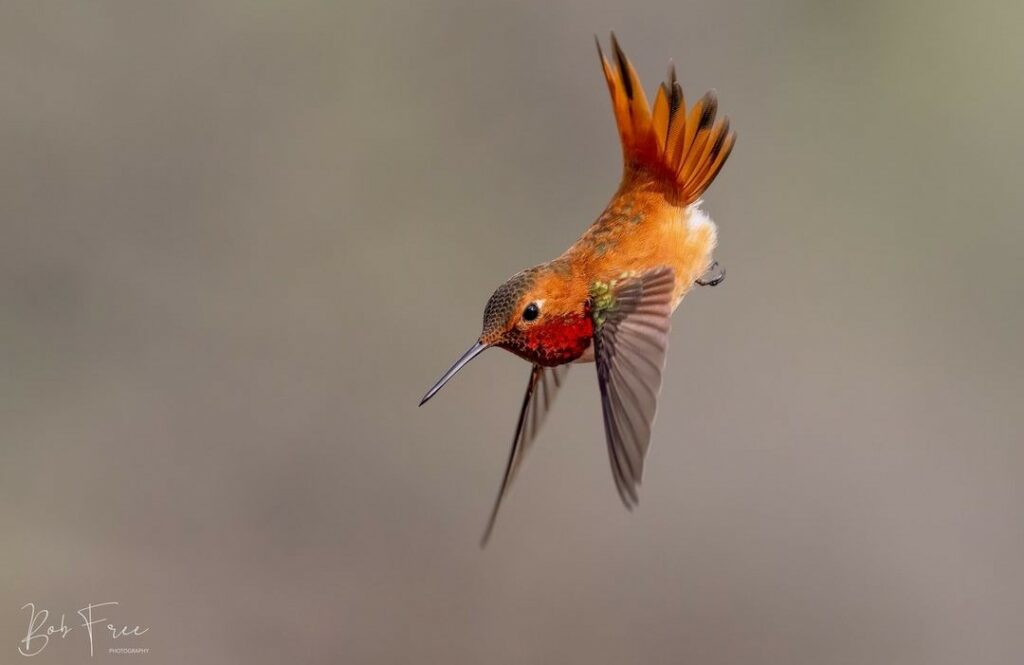
Photo by: Bob Free
It has even been observed that female mothers may attack squirrels and chipmunks that approach their nest too closely.
Due to their remarkable memory, Rufous hummingbirds have been observed to search for an abandoned hummingbird feeder years after it has been taken down.
Read my article: Hummingbird Adaptation and Remarkable Ability to Locate Food
Because of their unparalleled flying acrobatics, Rufous hummingbirds are fierce competitors at feeders, outmaneuvering all other species.
Rufous hummingbirds easily hybridize and cross-breed with other hummingbird species, such as Anna’s hummingbirds.
IUCN Red List classifies the Rufous hummingbird as “near threatened” because of habitat destruction in the Pacific Northwest.
In British Columbia, during a banding operation, the oldest living Rufous hummingbird was documented at 8 years and 10 months old.
Read my article: 3 Reasons Why Hummingbirds Are Banded
Mexican Violetear Hummingbirds:
MEXICAN VIOLETEAR (aka GREEN VIOLETEAR) HUMMINGBIRD – (Colibri thalassinus)
Conservation Status: Least concerned
Kingdom: Animalia
Phylum: Chordata
Class: Aves
Order: Apodiformes
Family: Trochilidae
Genus: Colibri
Species: C. thalassinus
Scientifically speaking, the Mexican Violetear is a species of hummingbird, Colibri thalassinus.
Thalassinus is a Latin term meaning “color of the sea.”
The characteristic violet patch of feathers on the sides of this hummingbird’s head, which mimics an ear, gave rise to its popular name.
The “violetear” description is accurate and vivid because of this bright patch that stands out against the bird’s otherwise green plumage.
Male Mexican Violetear hummingbirds:
The term “violet-ears” refers to the iridescent green color of male Mexican Violetear hummingbirds, which have brilliant violet ear patches on either side of their neck.
This hummingbird has metallic blue-green tail feathers with a black band underneath the bronze tail feathers in the center.
They weigh between 5 and 6 grams and have lengths ranging from 3.8 to 4.7 inches.
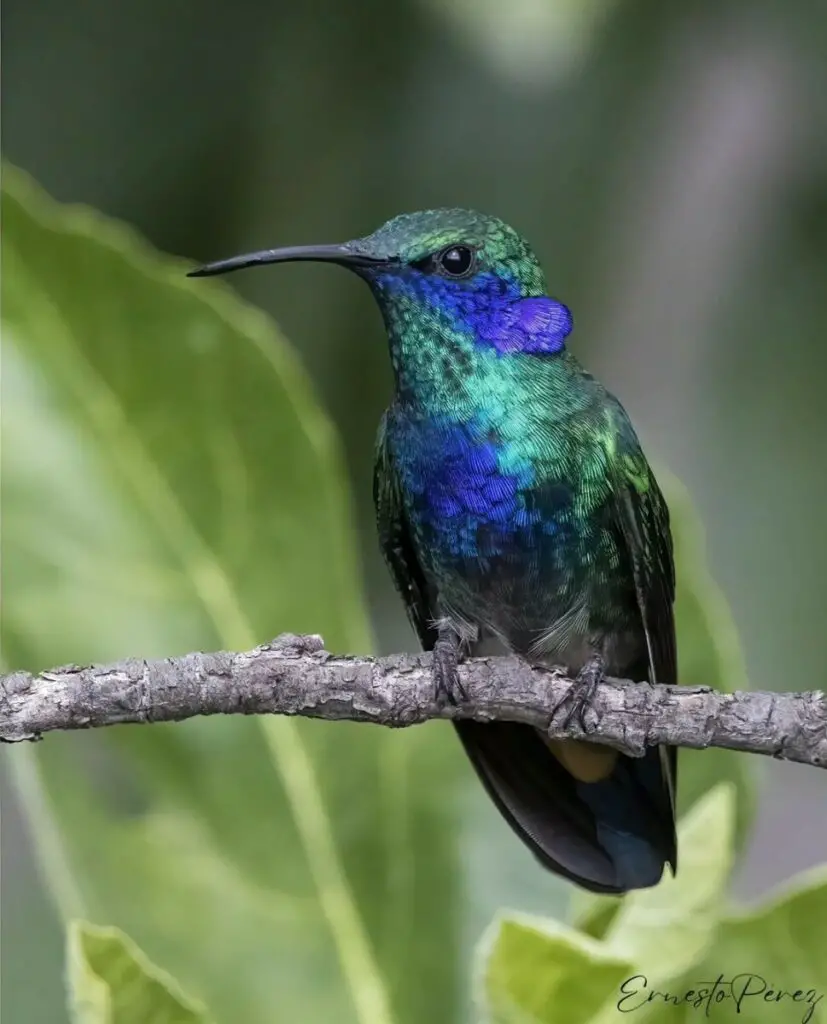
Photo by: Ernesto Perez
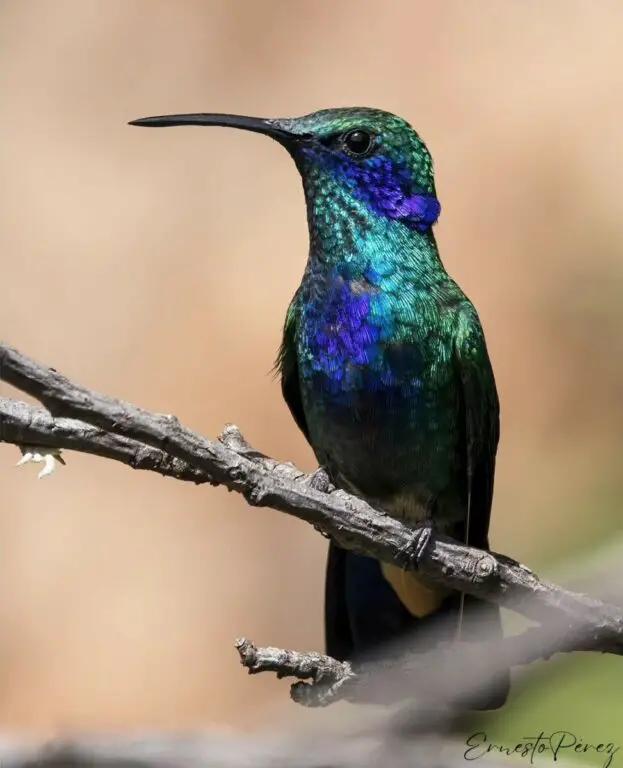
Photo by: Ernesto Perez
Female Mexican Violetear hummingbirds:
Females typically have a less vibrant coloration compared to males. They have a primarily green plumage, which can appear as a dull green or blue-green. The green is iridescent and may shine with different intensities and hues in various lighting conditions.
The violet ear patches are present in females but are often less pronounced than in males.
The underparts of the female are typically a duller green compared to the males, and they may have some grayish or whitish markings.
The tail is typically dark, forked, and has some blue or green iridescence. It is usually less spectacular than that of the male.
See my article: Hummingbird Parents: (Mating to Nesting)
Juvenile Mexican Violetear hummingbirds:
Male and female Mexican Violetear hummingbirds in their juvenile years resemble adult females until the male starts to develop the characteristic iridescent violet ear patches on either side of his neck.
Baby Mexican Violetear hummingbirds:
Baby Mexican Violetear hummingbirds are easily identified by their undertail coverts, which are white fluffy feathers near their bottom that will disappear as they age.
See my article: Baby Hummingbirds: (Egg to Fledgling)
To see the current sighting map of Vermont’s Mexican Violetear hummingbirds, click the link.
Hear the sounds of the Mexican Violetear hummingbird (Cornell Lab of Ornithology link).
Out of 45,756 hummingbird sightings in Vermont in 2023, only 4 was the Mexican Violetear hummingbird.
To see the current numbers of Vermont Mexican Violetear, click the link
From Mexico to Nicaragua, these hummingbird species are found on the outskirts of cloud forests, where they thrive in an environment with high levels of tropical humidity. It is common to see this dark hummingbird at forest margins and clearings.
Mexican Violetear hummingbirds are semi-nomadic. Since they have not been thoroughly examined, scientists know very little about their migration patterns.
However, based on available data, the Mexican Violetear is primarily distributed in northern South America, middle Mexico, and middle America.
Although Mexican Violetear hummingbirds are typically permanent residents of their natural habitat, a few individuals have strayed and ventured as far north as Wisconsin, Michigan, and even Canada.
Much like a lot of other hummingbird species, the Mexican Violetear hummingbird nests alone. Although they do not feed in flocks, these hummingbirds are observed in groups around flowering trees, such as the coffee-shading Inga tree, where they scavenge for nectar and insects.
In terms of social behavior, Mexican Violetear hummingbirds are generally solitary, especially outside of the breeding season.
They can be territorial, with males often defending prime feeding territories from other hummingbirds.
See my article: Why Hummingbirds Chase Each Other: Is it Friend or Foe?
The oldest known Mexican Violetear hummingbird was documented to be at least 11 years and 2 months old.
This information is based on banding records, where birds are captured, banded with a unique identification ring, and then potentially recaptured or found in the future.
The age of this particular Mexican Violetear was determined by the length of time between its initial banding and its last documented recapture or sighting.
See my article: 3 Reasons Why Hummingbirds Are Banded
Which Vermont Hummingbirds Are Most Frequently Seen In The State?
The most frequently seen Vermont hummingbirds are overwhelmingly the Ruby-throated hummingbirds.
Vermont hummingbirds listed in order of frequency seen:
Ruby-throated Hummingbird: 98.8% of all hummingbirds seen in Vermont are Ruby-throated hummingbirds.
Out of 10,000 Vermont hummingbirds seen, 9,988 will be a Ruby-throated hummingbird.
Rufous Hummingbird: 0.10% of all hummingbirds seen in Vermont are Rufous hummingbirds.
Out of 10,000 Vermont hummingbirds seen, only 10 will be a Rufous hummingbird.
Mexican Violetear Hummingbird: In 2023, out of 45,756 Vermont hummingbirds seen, only 4 were Mexican Violetear hummingbirds.
Where In The State Are Vermont Hummingbirds Seen?
- Ruby-throated Hummingbird: This is where, in Vermont, current sightings of this hummingbird are being reported.
- Rufous Hummingbird: This is where, in Vermont, current sightings of this hummingbird are being reported.
- Mexican Violetear Hummingbird: This is where, in Vermont, current sightings of this hummingbird are being reported.
Read my article Vermont Hummingbird Migration
For more information about hummingbirds, read my other hummingbird articles.
Happy Vermont Hummingbird Watching!
Backyard Visitors participates in affiliate programs which compensate us for referring traffic.

